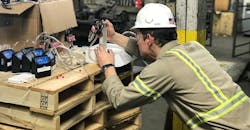OSHA Stresses Uniform Enforcement of Silica Standards
The U.S. Dept. of Labor’s Occupational Safety and Health Administration (OSHA) recently issued a compliance directive to ensure uniformity in inspection and enforcement procedures when addressing respirable crystalline silica exposures.
Sand casting operations' control of airborne silica is an object of specific attention for OSHA. In March 2016 the federal agency issued its final rule meant to minimize workers’ exposure to respirable crystalline silica — which, OSHA holds, may cause lung cancer, silicosis, chronic obstructive pulmonary disease and kidney disease in workers.
That rule began to go into effect in June 2016. As of June 23, 2018, manufacturers have been required to comply fully with the OSHA General Industry Respirable Crystalline Silica Rule.
The new directive provides OSHA compliance safety and health officers with guidance on how to enforce the silica standards’ requirements, including:
• Methods of compliance;
• Table 1 tasks and specified exposure control methods;
• Exposure assessments;
• Housekeeping;
• Respiratory protection;
• Regulated areas;
• Recordkeeping;
• Employee information and training;
• Medical surveillance; and
• Communication of hazards.
The directive also provides clarity on major topics, such as alternative exposure control methods when a construction-industry employer does not fully and properly implement Table 1, variability in sampling, multi- employer situations, and temporary workers.
OSHA began enforcing most provisions of the construction standard in September 2017, with enforcement of the requirements for sample analysis starting in June 2018.
Enforcement of most of the general industry and maritime standards began in June 2018, with enforcement of some medical surveillance requirements commencing on June 23, 2020.
On June 23, 2021, OSHA will begin enforcing requirements for engineering controls for hydraulic fracturing operations in the oil-and-gas industry.
